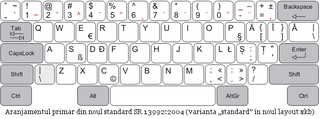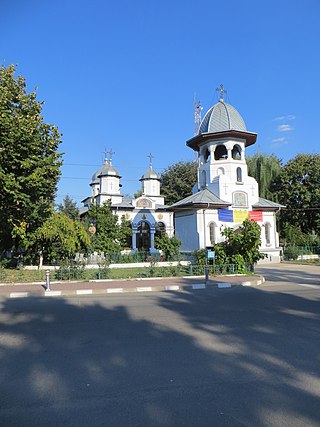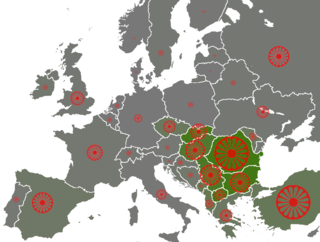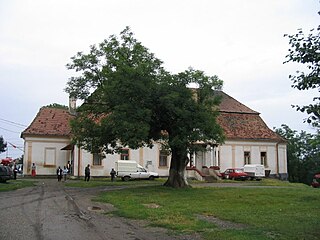Sources
- Romanian 2002 Census Results Database: "Structura Etno-demografică a României" (in Romanian). Centrul de Resurse pentru Diversitate Etnoculturală. Retrieved 17 December 2024.
This list contains Romanian urban localities (municipalities or cities/towns) in which Roma people make up over 5% of the total population, according to the 2011 census. The Roma are an ethnic group which make up 3.3% of Romania's population. There are several rural localities (communes and villages) which also have Roma populations exceeding 5% of the total population, even though those are not listed here.
In localities where Roma make up more than 20% of the population, the Romani language can be used when addressing local authorities, while state-funded education and bilingual signs are also provided. This arrangement applies in several communes, as well as in three towns: Bechet, Budești and Ulmeni.

The Romani people, also known as the Roma, are an Indo-Aryan ethnic group who traditionally lived a nomadic, itinerant lifestyle. Linguistic and genetic evidence suggests that the Roma originated in the Indian subcontinent, in particular the region of Rajasthan. Their first wave of westward migration is believed to have occurred sometime between the 5th and 11th centuries. They are thought to have arrived in Europe around the 13th to 14th centuries. Although they are widely dispersed, their most concentrated populations are believed to be in Bulgaria, Hungary, Romania, Serbia and Slovakia.

Sibiu County is a county of Romania, in the historical region of Transylvania. Its county seat is the namesake town of Sibiu.
Romani may refer to:

Beyond the official Romanian language, multiple other languages are spoken in Romania. Laws regarding the rights of minority languages are in place, and some of them have co-official status at a local level. Although having no native speakers, French language is also a historically important language in Romania, and the country is a member of the Organisation internationale de la Francophonie.
About 9.3% of Romania's population is represented by minorities, and 13% unknown or undisclosed according to 2021 census. The principal minorities in Romania are Hungarians and Romani people, with a declining German population and smaller numbers of Poles in Bukovina, Serbs, Croats, Slovaks and Banat Bulgarians, Ukrainians, Greeks, Jews, Turks and Tatars, Armenians, Russians, Afro-Romanians, and others.

Romani people in Romania, locally and pejoratively referred to as the Țigani, constitute the second largest ethnic minority in the country. According to the 2021 census, their number was 569,477 people and 3.4% of the total population. The size of the total population of people with Romani ancestry in Romania is even more, with different estimates varying from 4.6 percent to over 10 percent of the population, because many people of Romani descent do not declare themselves Roma. For example, in 2007 the Council of Europe estimated that approximately 1.85 million Roma lived in Romania, based on an average between the lowest estimate and the highest estimate available at the time. This figure is equivalent to 8.32% of the population. On the other hand, less than half are native speakers of the Romani language.

Bolintin-Vale is a town in Giurgiu County, Muntenia, Romania with a population of 12,806 as of 2021. The town administers three villages: Crivina, Malu Spart, and Suseni. It is the second largest city in the county; proximity to the capital, Bucharest, has helped the local economy. It officially became a town in 1989, as a result of the Romanian rural systematization program.

Bonțida is a commune in Cluj County, Transylvania, Romania. It is composed of four villages: Bonțida, Coasta (Gyulatelke), Răscruci (Válaszút), and Tăușeni (Marokháza).

Pălatca is a commune in Cluj County, Transylvania, Romania. It is composed of five villages: Băgaciu (Kisbogács), Mureșenii de Câmpie, Pălatca, Petea (Magyarpete), and Sava (Mezőszava).

Săcuieu is a commune in Cluj County, Transylvania, Romania. It is composed of three villages: Rogojel (Havasrogoz), Săcuieu, and Vișagu (Viság).

Sânmartin is a commune in Cluj County, Transylvania, Romania. It is composed of eight villages: Ceaba (Bálványoscsaba), Cutca (Kötke), Diviciorii Mari (Nagydevecser), Diviciorii Mici (Kisdevecser), Măhal (Mohaly), Sâmboieni (Erdőszombattelke), Sânmartin, and Târgușor (Kékesvásárhely).

Ulmeni is a town in Maramureș County, Crișana, Romania. It was declared a town in 2004. The town administers seven villages: Arduzel (Szamosardó), Chelința (Kelence), Mânău (Monó), Someș-Uileac (Szilágyújlak), Tohat (Szamostóhát), Țicău (Szamoscikó), and Vicea (Vicsa).

Romani people in Bulgaria constitute Europe's densest Roma minority. The Romani people in Bulgaria may speak Bulgarian, Turkish or Romani, depending on the region.

Romani CRISS is a Romanian non-government organisation which seeks to protect the rights of the country's Romani minority and to prevent discrimination against the Roma, who officially make up 3.3% of the country's population as of 2011, with an unofficial 2002 estimate of between 1.5 and 2 million, representing at least 8-9% of the population. It also conducts a series of projects in order to improve the situation of the Roma in education and health care. Romani CRISS was founded on April 4, 1993, and its executive director 2005-2012 was Margareta Matache. Its current executive director is Marian Mandache.

Anti-Romani sentiment is an ideology which consists of hostility, prejudice, discrimination, racism and xenophobia which is specifically directed at Romani people. Non-Romani itinerant groups in Europe such as the Yenish, Irish and Highland Travellers are frequently given the name "gypsy" and as a result, they are frequently confused with the Romani people. As a result, sentiments which were originally directed at the Romani people are also directed at other traveler groups and they are frequently referred to as "antigypsy" sentiments.

The Romani diaspora refers to the presence and dispersion of Romani people across various parts of the world. Their migration out of the Indian subcontinent occurred in waves, with the first estimated to have taken place between the 1st and 2nd century AD. They are believed to have first arrived in Europe in the early 12th century, via the Balkans. They settled in the areas of present-day Turkey, Greece, Serbia, Romania, Croatia, Moldova, Bulgaria, North Macedonia, Hungary, Albania, Kosovo, Montenegro, Bosnia and Herzegovina, Czech Republic, Slovenia and Slovakia, by order of volume, and Spain. From the Balkans, they migrated throughout Europe and, in the 19th and later centuries, to the Americas. The Roma population in the United States is estimated at more than one million.

Voivodeni is a commune in Mureș County, Transylvania, Romania. It is composed of two villages, Toldal (Toldalag) and Voivodeni. The former village is much less populated than the latter.
Romani people, or Roma, are the fourth largest ethnic group in Serbia, numbering 131,936 (1.98%) according to the 2022 census. However, due to a legacy of poor birth registration and some other factors, this official number is likely underestimated. Anywhere between 46,000 to 97,000 Roma are internally displaced from Kosovo after 1999.

There have been Romani people in Croatia for more than 600 years and they are concentrated mostly in the northern regions of the country.